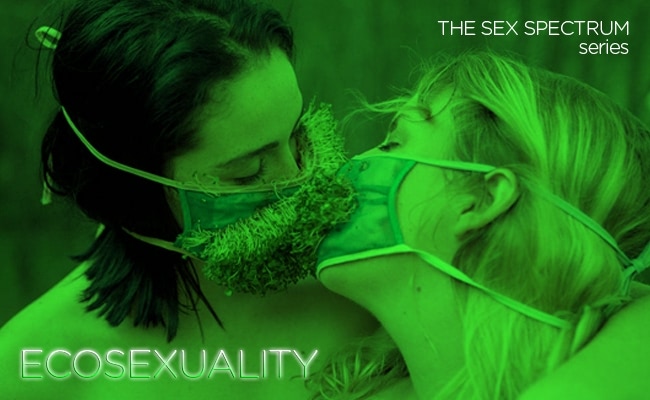Are you yearning for real connection? Are you longing for sanctuary with nature? Are you willing to embrace the Earth as your lover? These questions set the right mood to introduce the first part of The Sex Spectrum, a seven part series to explore alternative sexual cultures and challenge the social and cultural dominant dimensions. First up is ecosexuality, a growing movement rooted in art and activism at the intersection of sexuality and ecology. Additionally, some consider ecosexuality their sexual identity, in which the biosphere becomes their lover.
The term “ecosexual” stems from the early 2000s when it was used to describe an environmentally conscious person on online dating profiles. It took some years for it to move beyond the dating niche and become a widespread phenomenon that describes new ways of relating intimately with the environment and individual lovers, in order to reframe our perspective on the wellbeing of our planet. In short, ecosexuality could be regarded an exit strategy for surviving the Anthropocene.
The geological epoch of the Anthropocene defines the human impact on Earth's ecosystems, thus giving shape to nature and placing humanity on the brink of extinction. In his essay Evolving Toward a Better Anthropocene, environmental scientist Erle Ellis points out that our species is not the first to have altered its external environment, and argues the evolution of green plants had already changed the atmosphere by producing oxygen. Accordingly, a symbiotic relationship between the two could be implemented to engender favorable outcomes for people and nonhuman nature.
On her album Biophilia, Icelandic artist Björk explores this relationship and guides her audience through a world of human emotions, entangled with natural phenomena. The album becomes part of the symbiosis and possesses a post-human quality, which takes a return to origins as a means of imploding hierarchies between living things and their surroundings. Biophilia considers nature itself an instrument, and allows the sexes to blend into a self-replicating whole.
The title of the album refers to the attraction to everything that lives and grows, which was initially theorized in 1964 by psychoanalyst and philosopher Erich Fromm in his book The Heart of Man: Its Genius for Good and Evil. The author describes biophilous tendencies as to unite with divergent entities, to actualize themselves as an intrinsic part of socialization, starting from a molecular level. Yet Fromm believes that for biophilia to emerge, societal conditions must be in place.
In a much ridiculed television interview in 1986, Prince Charles spoke about the significance of talking to his plants. Allegedly this idea dates back to 1848, when experimental psychologist Gustav Fechner suggested that plants might be capable of feeling human-like emotions. Turns out, plants do have sensory abilities. Next to responding to light and the sense of touch, a South Korean scientist revealed the outcome of his experimentation in 2007, indicating playing Beethoven’s ‘Moonlight Sonata’ to rice plants led them to grow faster and blossom sooner.
According to the Center for Biological Diversity, 68% of the 300.000 known species of plants are threatened and risk extinction. Besides that, nearly 90% of the world's plant activity is to be found in ecosystems where humans play a significant role. So why not increase the planet’s resilience through sexual sovereignty?
Plants are sentient beings, if we begin to regard them as such, this will alter our environment into neo-erotic chambers of undiscovered sex, in which the relationship with nature performs a post-anthropocentric interpretation of agency for planetary change, with the impulse of creation itself. Welcome to the age of eco-eroticism.

Share your thoughts and join the technology debate!
Be the first to comment